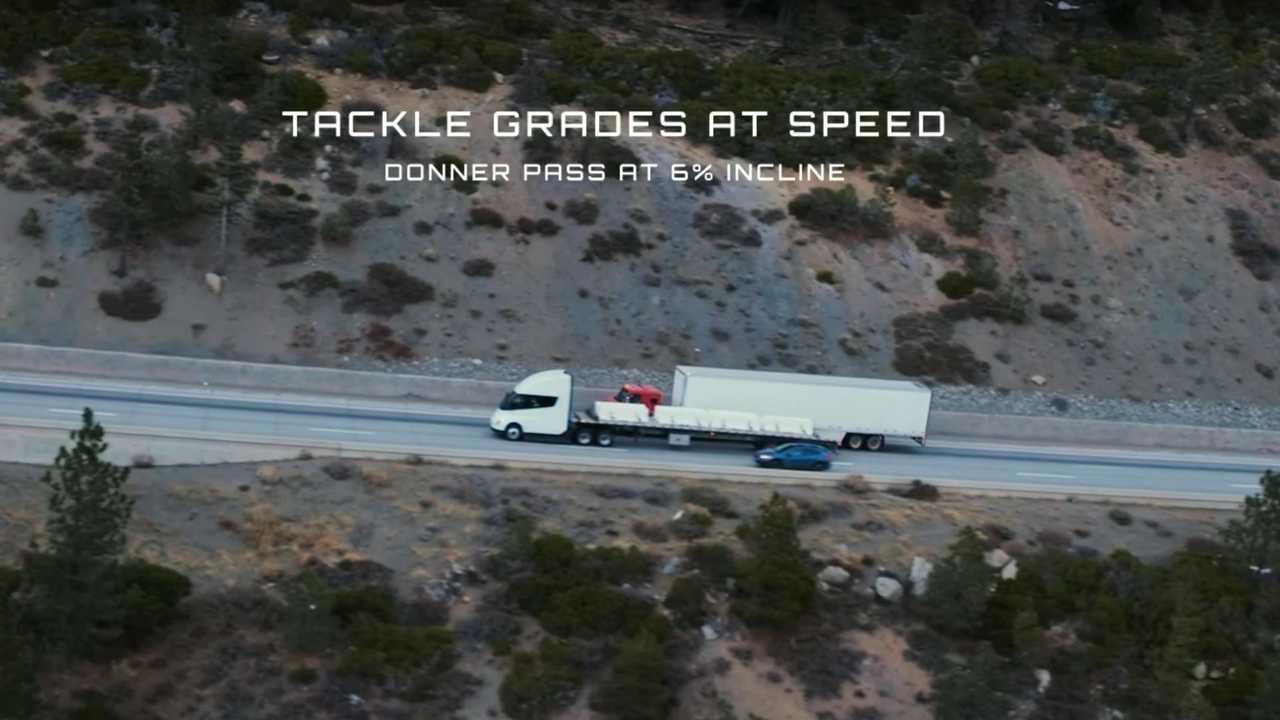Tesla has began buyer deliveries of its Class 8 all-electric Semi truck, revealing a number of new issues about its powertrain.
In response to the producer, the Tesla Semi “is a beast” with a complete energy output thrice increased than within the case of any diesel truck on the highway. Nevertheless, Tesla doesn’t say the precise peak or steady energy output quantity.
Excessive energy doesn’t shock us contemplating that the car’s acceleration from 0 to 60 mph (96.5 km/h) is promised to take simply 20 seconds (when totally loaded). By the way in which, totally loaded means 82,000 lbs (37,195 kg) Gross Mixture Weight (GCW), as a result of the allowed GCW for BEVs is 2,000 lbs increased than for diesel autos – 80,000 lbs.
That is most likely why a considerably loaded Tesla Semi was capable of simply speed up when driving uphill on a 6% incline in Donner Cross within the northern Sierra Nevada, as proven within the video (37:30). The car simply handed one other semi.
Elon Musk provides that, to a point, the Tesla Semi drives like a standard truck, though it is greater and heavier.

Now let’s get into particulars. The Tesla Semi is supplied with a brand new tri-motor system, which consists of three impartial electrical motors (in comparison with 4, anticipated for use in 2017 when the Semi was introduced).
The motors are, after all, used to energy the 2 rear axles – 2nd and third – because the entrance axle is just not powered.
An attention-grabbing factor is that the electrical motors have carbon-sleeved rotors – identical to in the Tesla Model S/Model X Plaid introduced in 2021 (see the presentation of the front motor and two rear motors here). Which means that Tesla put every part it needed to maximize the output of the drive unit.

The primary rear axle (or the second axle if you want) has one electrical motor, continually engaged by a single-speed discount gear. It is optimized for freeway driving.
In the meantime, the opposite two electrical motors are used on the rear axle to individually energy the left and proper wheels. These two motors are optimized for acceleration and torque.
Relying on the circumstance (particularly velocity and accelerator pedal place), the 2 rear motors are robotically and seamlessly engaged or disengaged mechanically from the drive axle to reduce vitality losses.
Right here is the way it works:
It is vital to notice that the Tesla Semi utilized powertrain parts borrowed from its different electrical autos – together with electrical motors and inverters, the warmth pump system and the infotainment system.
In fact, there have been modifications, however total using mass produced components allowed Tesla to attain a a lot increased degree of reliability in comparison with another situation of creating all-new methods for a comparatively low-volume car (in comparison with thousands and thousands of automobiles).
The Tesla Semi’s powertrain, like within the case of different trendy electrical autos, is totally ready for intensive recuperation. The corporate’s check has proven that it is potential to go downhill utilizing regenerative braking and have principally chilly mechanical brakes on the backside.
Tesla Semi specs (2022):
- Totally loaded at 82,000 lbs (37,195 kg) Gross Mixture Weight
- Vary: about 300 miles (483 km) or 500 miles (804 km)
(two battery choices) - Vitality Consumption: lower than 2 kWh/mile (1.24 kWh/km)
- Estimated battery capability (based mostly on vary and vitality consumption): decrease than 600 kWh or 1,000 kWh (1 MWh)
- Acceleration 0-60 mph (96.5 km/h): 20 seconds (when totally loaded)
- Pace up a 5% Grade: Freeway velocity restrict
- Powertrain: 3 impartial motors (vs. 4 motors within the preliminary specs in 2017)
– two electrical motors for acceleration on the rear axle (with automated disengage)
– one electrical motor for freeway driving on the second axle (continually engaged)
– carbon-sleeved rotors identical to Plaid - Quick Charging: as much as 70% of vary in half-hour
- Gas Financial savings (est.): as much as $200,000 over 3 years
Preliminary costs (at unveiling in 2017):
- Anticipated Base Worth (300 mile vary) – $150,000
- Anticipated Base Worth (500 mile vary) – $180,000
- Base Reservation – $20,000
- Anticipated Founders Sequence Worth – $200,000
- Founders Sequence Reservation – $200,000
* Costs displayed in USD. Worldwide pricing will differ.







